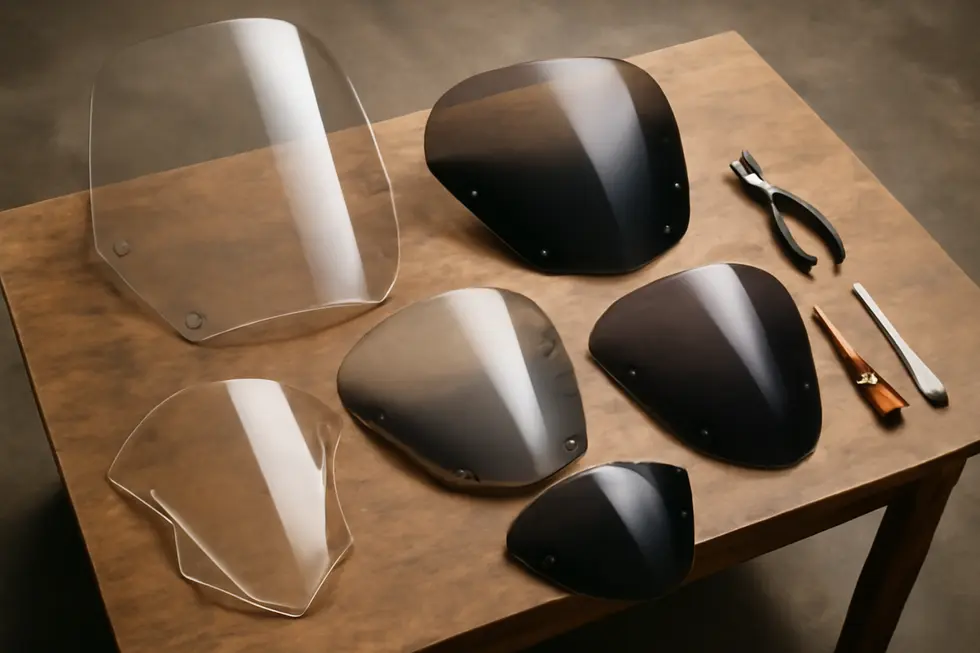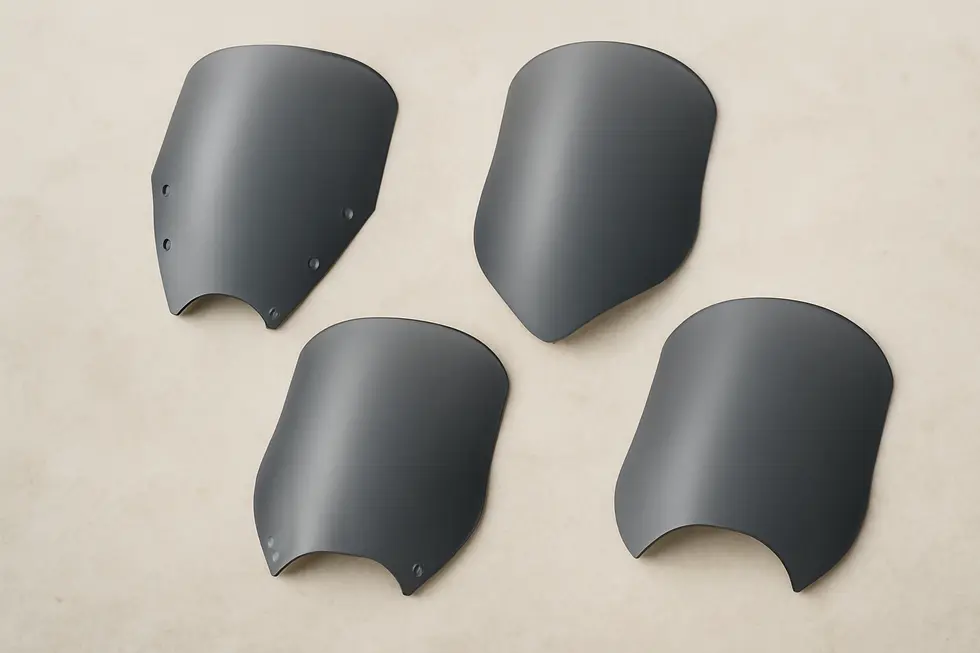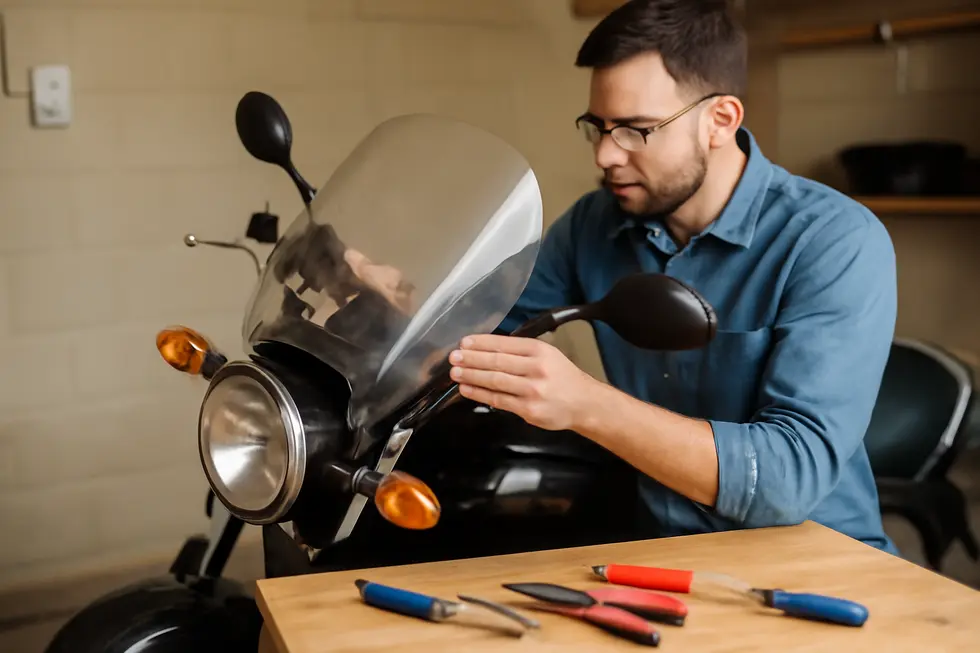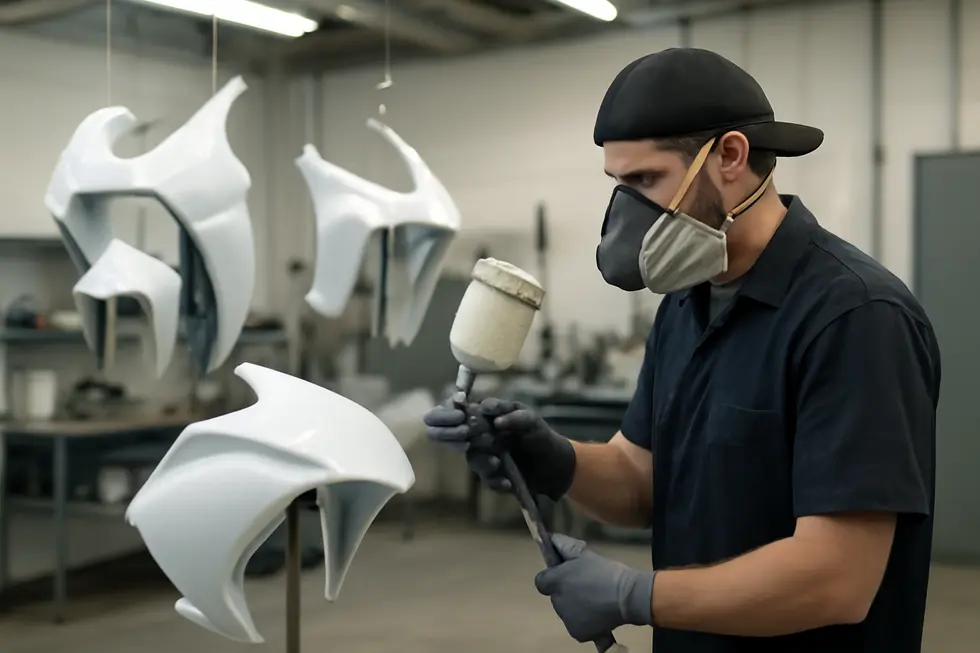Essential Guide to Replacing Your Motorcycle Fairing Windshield
October 17, 2025 | by summitfairings

Introduction
Replacing a motorcycle fairing windshield not only enhances the visual appeal of your bike, but it also plays a crucial role in rider comfort and safety. Understanding the intricacies of selecting the right replacement, the installation process, material options, and fitment types will empower motorcycle business owners to provide better service and products to customers. Our comprehensive guide covers each facet of motorcycle fairing windshield replacement, ensuring that you can make informed decisions that resonate with your clientele’s needs.
Tables of Contents
Chapter 1: Choosing the Right Motorcycle Fairing Windshield for Enhanced Performance
- Navigating Material Selections for Motorcycle Fairing Windshield Replacement
- Finding the Perfect Motorcycle Fairing Windshield: Style, Fit, and Functionality
- Navigating the Installation Process for Optimal Motorcycle Windshield Replacement
- Navigating the Perfect Match: Sizing and Functional Elements of Motorcycle Fairing Windshields
Chapter 2: Expert Techniques for a Smooth Motorcycle Fairing Windshield Replacement
- A Comprehensive Manual for Installing Your New Motorcycle Fairing Windshield
- Critical Tools for a Seamless Motorcycle Windshield Installation
- Overcoming Common Installation Obstacles for Windshield Replacement
- Essential Safety Protocols for Replacement Windshield Installation
Chapter 3: Choosing the Right Materials for Motorcycle Fairing Windshield Replacement
- Understanding the Benefits of Polycarbonate and Acrylic in Motorcycle Windshields
- Understanding the Unique Advantages of Lucite and Fiberglass in Motorcycle Fairing Windshield Applications
- The Role of Material in Motorcycle Fairing Windshield Replacement: A Deeper Look at Options and Compatibility
- Balancing Cost and Performance: A Guide to Material Selection for Windshields
Chapter 4: Navigating the Essentials of Motorcycle Fairing Windshield Compatibility
- Decoding Fitment Types for Motorcycle Fairing Windshields
- Decoding Fitment Types: Finding the Right Windshield for Your Motorcycle
- Decoding Replacement Fitment Types: Essential Insights for Motorcycle Enthusiasts
- The Crucial Balance of Fitment Types in Motorcycle Fairing Windshield Replacement
Chapter 5: Evaluating the Financial Implications of DIY Motorcycle Fairing Windshield Replacement
- Assessing the Cost-Benefit of DIY Windshield Replacement for Motorcyclists
- Weighing the Benefits and Risks of DIY Fairing Windshield Replacement
- Balancing Benefits and Risks in DIY Windshield Replacements
- Personal Pride and Practicality: The Appeal of DIY Windshield Replacement for Motorcyclists
Chapter 6: Navigating the Online Marketplace for Motorcycle Fairing Windshield Replacements
- Your Guide to Major Online Retailers for Windshield Acquisition
- Finding the Best Deals on Motorcycle Fairing Windshield Replacements: A Price Comparison Guide
- Deciding Factors for Choosing Motorcycle Fairing Windshields and Accessories
- Finding the Right Fit: A Guide to Motorcycle Fairing Windshield Compatibility and Sourcing
Chapter 1: Choosing the Right Motorcycle Fairing Windshield for Enhanced Performance

1. Navigating Material Selections for Motorcycle Fairing Windshield Replacement
When considering the replacement of your motorcycle fairing windshield, understanding materials is critical to achieving optimal performance and aesthetics. Fairings are designed to enhance both protection and aerodynamics, usually made from strong yet lightweight materials like ABS plastic, fiberglass, and carbon fiber. ABS plastic is favored for its cost-effectiveness and impact resistance, making it a reliable choice for factory installations. In contrast, fiberglass serves well in the aftermarket, offering easy repair options and an appealing custom appearance.
For the windshields themselves, materials such as polycarbonate and acrylic offer clarity and sturdiness. Polycarbonate, known for its exceptional resilience against impacts, ensures a clear view while shielding against the wind and debris. Acrylic, while equally clear, presents a balance of optical clarity with aesthetic appeal. These material choices profoundly influence the riding experience.
In your selection process, it’s essential not only to consider material properties but also to ascertain compatibility with your motorcycle’s existing design and features. For further insights into tailoring your bike’s appearance and performance, explore the vast options available through specialized retailers like Summit Fairings.
2. Finding the Perfect Motorcycle Fairing Windshield: Style, Fit, and Functionality
Selecting the ideal motorcycle fairing windshield is essential not only for protection but also for enhancing the bike’s overall style. Start by ensuring that the windshield is compatible with your specific motorcycle model; manufacturers like Arlen Ness offer options that are tailored for precise fitments, such as the popular Harley-Davidson batwing style.
Windshields come in various designs, from sporty, short screens that minimize wind resistance to taller touring models that shield against the elements during long rides. The shape and material also greatly impact both performance and aesthetic appeal. Common choices include polycarbonate and acrylic; each has its merits in clarity, strength, and scratch resistance.
As you explore styles, consider how airflow dynamics can improve your ride. For instance, some designs feature “hips” that improve stability at higher speeds. Installation methods are vital; ensure you use proper techniques and tools or consider professional help for a seamless fit. Ultimately, the right replacement windshield marries form and function for an optimal riding experience.
3. Navigating the Installation Process for Optimal Motorcycle Windshield Replacement
Replacing a motorcycle fairing windshield is as much about skillful installation as it is about choosing the right part. Start by stabilizing your motorcycle using a center stand; this technique helps maintain proper alignment and balances weight during the process. Carefully remove the old windshield, unscrewing each mounting point without scratching the fairing or compromising nearby components. It’s wise to inspect the well nuts for wear and replace them if necessary, ensuring a snug fit for your new windshield. For some models, mirrors or other parts may require temporary removal to facilitate access.
When selecting a replacement windshield, factors such as aerodynamics, visibility, and personal style play pivotal roles. After installation, consider enhancing airflow with add-on accessories for even better wind protection. Whether you choose a direct fit or a more universal option, follow installation guidelines to avoid potential wiring or structural complications, especially in intricate fairing systems. For more in-depth insights, explore practical articles on motorcycle fairings at https://blog.summitfairings.com/blog/.
4. Navigating the Perfect Match: Sizing and Functional Elements of Motorcycle Fairing Windshields
Selecting the right motorcycle fairing windshield is essential to optimizing your ride. The ideal windshield enhances rider comfort by deflecting wind and debris while complementing your motorcycle’s style. Key considerations include height, width, angle, and material. Height matters greatly; it should ideally align with your eyesight when seated to ensure clear visibility. The width should match or exceed your bike’s fairing for effective wind protection, and the angle can significantly influence wind deflection—steeper angles are typically better for high-speed rides. Material choice is also critical; polycarbonate offers durability, while acrylic provides clarity but can scratch easily.
Additional functional aspects, like aerodynamics and adjustability, should not be overlooked. A well-designed windshield can minimize noise and fatigue, while electric adjustments can enhance versatility on the go. Finally, aesthetics matter; choose a windshield that resonates with your bike’s look. For a range of choices, explore a selection of motorcycle fairings that reflect your style.
Chapter 2: Expert Techniques for a Smooth Motorcycle Fairing Windshield Replacement

1. A Comprehensive Manual for Installing Your New Motorcycle Fairing Windshield
To successfully replace your motorcycle fairing windshield, start with preparation and safety: park your motorcycle on a stable surface, preferably using a center stand, and gather tools such as screwdrivers and Allen wrenches. Wear gloves to avoid fingerprints on your new windshield.
Next, remove the old windshield by locating and unscrewing all bolts or screws. Support the windshield while doing this to prevent damage. Inspect the mounting points of your fairing; clean them and replace any worn hardware as necessary.
Align the new windshield with the mounting holes, threading bolts by hand to prevent cross-threading. Once the windshield is secure, gradually tighten bolts for a snug fit, alternating sides to maintain alignment without over-tightening, which may crack the fairing. Finally, conduct thorough inspections for secure fitting, clean fingerprints off the surface, and take a careful test ride to ensure everything is stable.
You can explore more options for compatible fairings and windshields at Summit Fairings.
2. Critical Tools for a Seamless Motorcycle Windshield Installation
Replacing a motorcycle fairing windshield requires not only skill but also a well-equipped toolkit to ensure a smooth and effective installation process. Start with screwdrivers, specifically both flathead and Phillips types, to tackle the various screws securing the windshield to the fairing. A socket set—including both metric and SAE sockets—will facilitate quick work on bolts, especially when paired with extensions for reaching recessed areas. Don’t forget a complete set of Torx drivers, as many modern motorcycles utilize these fasteners.
Additionally, pliers are invaluable for handling clips and wiring, while combination wrenches in diverse sizes will ensure access to tight spots. For more complex tasks, such as installing riveted attachments, a rivet gun will be essential, along with a power drill if you need to create new mounting holes. Always prioritize safety with gloves and goggles, and remember to consult your bike’s manual for specific needs. With the right tools, your windshield replacement will be effective and professional, enhancing both protection and style.* For further insights into necessary gear, check out Cycle Gear’s Stockton Roadside Tool Kit.
3. Overcoming Common Installation Obstacles for Windshield Replacement
Replacing a motorcycle fairing windshield involves navigating several potential issues that can complicate the process. One of the primary challenges is compatibility; not every windshield fits every motorcycle model. A mismatched windshield can create alignment problems, leading to gaps that may compromise safety and aerodynamics.
Additionally, you may encounter mounting hardware mismatches, particularly when transitioning from original equipment manufacturer (OEM) parts to aftermarket options. This scenario often calls for adapter kits or modifications. For bikes with integrated electronics, ensuring proper wiring connections is vital to avoid electrical issues, which can affect both lighting and audio systems. Material compatibility also plays a role; for example, windshields made from polycarbonate may expand differently compared to fairing materials like ABS plastic.
To streamline your installation process, always verify windshield fitment before purchasing, adhere strictly to the manufacturer’s installation instructions, and confirm the compatibility of all mounting hardware. By proactively addressing these common problems, riders can execute a successful windshield replacement with confidence.
4. Essential Safety Protocols for Replacement Windshield Installation
Replacing a motorcycle fairing windshield demands careful attention to safety protocols to facilitate a successful installation. First and foremost, ensure you have the proper tools and equipment at hand, such as screwdrivers and Allen wrenches. Using an O-ring and a surface-finish-safe detergent for cleaning the windshield and fairing not only preserves the integrity of materials but also enhances the installation process.
While DIY installations may appear manageable, considering professional assistance is wise, particularly with fairings equipped with integrated components like LED lights or audio systems. Selecting a vehicle-specific windshield is also crucial; this step guarantees compatibility and helps avoid any fitting issues.
Materials like polycarbonate or acrylic are preferred due to their durability and visibility. Post-installation checks are imperative to confirm everything is secure. Always adhere to the manufacturer’s instructions and conduct a test ride to identify any possible problems before hitting the road. Regular maintenance checks thereafter will help uphold safety and performance standards.
Chapter 3: Choosing the Right Materials for Motorcycle Fairing Windshield Replacement

1. Understanding the Benefits of Polycarbonate and Acrylic in Motorcycle Windshields
When considering a replacement for your motorcycle fairing windshield, the choice between polycarbonate and acrylic is crucial. Polycarbonate, a thermoplastic polymer, stands out for its unmatched impact resistance, making it ideal for high-performance motorcycles. It offers the ability to withstand significant force without shattering, thereby enhancing rider safety. Additionally, polycarbonate can be treated with hardcoatings for added scratch and UV resistance, although it may still develop scratches over time.
In contrast, acrylic, while lighter and known for superior optical clarity, is more brittle and can shatter on impact. Its affordability makes it a popular choice among budget-conscious riders, but it lacks the resilience offered by polycarbonate. Ultimately, for those prioritizing safety and durability, investing in a hardcoated polycarbonate windshield is advisable. However, if clarity and cost are your primary concerns, acrylic may serve as a feasible alternative. For a broader selection of options, explore Summit Fairings to find the right fit for your bike.
2. Understanding the Unique Advantages of Lucite and Fiberglass in Motorcycle Fairing Windshield Applications
When considering materials for motorcycle fairing windshield replacement, Lucite (acrylic) and fiberglass emerge as leading contenders, each offering distinct advantages. Lucite is celebrated for its exceptional optical clarity, making it the ideal choice for windshields where visibility is paramount. It is lightweight and easily molded into intricate designs, allowing for smooth finishes that enhance aesthetic appeal. While it provides good impact resistance, it lacks the flexibility found in other materials. Conversely, fiberglass boasts impressive strength and durability, making it a go-to for structural components of fairings. Although it is heavier and less transparent than Lucite, its flexibility allows for robust performance in custom applications. Moreover, fiberglass repairs are often simpler, with cracks or chips easily patched and sanded. Choosing between these materials largely depends on prioritizing clarity for windshields or the strength required for fairing bodies. For more tips on selecting motorcycle fairings and related components, explore our resources at Summit Fairings.
3. The Role of Material in Motorcycle Fairing Windshield Replacement: A Deeper Look at Options and Compatibility
The choice of material for motorcycle fairing windshields plays a crucial role not only in installation processes but also in the overall performance, durability, and aesthetic appeal of the replacement part. Polycarbonate stands out for its exceptional impact resistance and clarity, which makes it the preferred material for both OEM parts and premium aftermarket options. Its ability to be molded into aerodynamically optimized shapes enhances ride comfort and wind protection. However, care must be taken during installation as it may require custom fitting when adapted to universal designs.
In contrast, acrylic offers superior clarity but is more prone to cracking, which may influence its application in custom projects or specific touring setups where long-distance visibility is paramount. ABS plastic provides a cost-effective option, frequently seen in fairing bodies, though not ideal for transparent sections due to its opacity.
Lastly, even though fiberglass is typically limited to custom fairings, its flexibility in design remains an attractive attribute. When choosing a material for a motorcycle fairing windshield replacement, consideration should be given to compatibility with the bike’s structure and potential modifications needed to ensure proper installation. To explore various fairing materials and their unique properties, visit Summit Fairings Blog.
4. Balancing Cost and Performance: A Guide to Material Selection for Windshields
The material selection for motorcycle fairing windshields is crucial, as it influences both the rider’s experience and the aerodynamic efficiency of the bike. At the forefront of budget-friendly options is ABS plastic. While it remains the least expensive choice, its weight can be a downside for performance enthusiasts. Those seeking a bit more versatility might lean towards fiberglass, which offers a balance between cost and customization, albeit with slightly less impact resistance compared to ABS.
For the ultimate performance, carbon fiber stands out due to its exceptional strength-to-weight ratio, making it ideal for racing applications. However, the associated price tag can be prohibitive. When focusing specifically on windshields, polycarbonate is favored for its optical clarity and resistance to UV damage, though it requires more careful handling due to its susceptibility to scratching. Conversely, acrylic is a budget-friendly alternative that excels in visual clarity but can lose its durability under prolonged UV exposure. Evaluating these materials carefully against your riding style and budget will ensure that you make an informed decision, optimizing both performance and cost efficiency. For more insight into motorcycle fairings, visit this comprehensive resource.
Chapter 4: Navigating the Essentials of Motorcycle Fairing Windshield Compatibility

1. Decoding Fitment Types for Motorcycle Fairing Windshields
Motorcycle fairing windshields serve as both protective barriers and aerodynamic elements, crucial to enhancing the riding experience. Selecting the right fitment type ensures that your windshield efficiently shields you from wind and debris while integrating seamlessly with your motorcycle’s design. The landscape of motorcycle fairing fitment consists of several categories: Exact Fit Parts, designed for specific bike models with precise measurements; Universal Fit Parts, which present versatility yet may require customization; and Custom Fit Parts, tailored for unique or modified motorcycles that necessitate professional installation. Material choices, ranging from sturdy ABS plastic to lightweight polycarbonate, add depth to functionality and aesthetic appeal.
Proper installation of the selected windshield is vital, involving correct alignment with mounting points and secure fastening. Understanding these variations and their implications allows riders to enhance their motorcycle’s aerodynamics and rider comfort effectively. For an abundance of options and fitment advice, resources like Summit Fairings provide comprehensive insights on choosing the perfect windshield.
2. Decoding Fitment Types: Finding the Right Windshield for Your Motorcycle
In the realm of motorcycle fairing windshield replacement, understanding fitment types is essential for ensuring that the right windshield not only complements the motorcycle’s design but also enhances its performance. The most common fitment types include exact fit, universal fit, custom fit, and mounting kit dependent options.
Exact fit windshields are tailor-made for specific motorcycle models, ensuring perfect alignment with existing mounting points. This is particularly beneficial for sportbikes, where aerodynamics and aesthetics are crucial. In contrast, universal fit options provide flexibility, allowing for installation on various models, though they may require minor adjustments during setup. Custom fit solutions are perfect for riders who wish to personalize their bikes, although they often need expert installation to ensure proper fit. Lastly, some windshields necessitate a separate mounting kit, which connects various components securely, enhancing overall stability.
Choosing the correct type not only affects the visual appeal but can also impact performance—reducing drag and improving fuel efficiency. Thus, thorough research and understanding of these nuances are vital before proceeding with a windshield replacement.
3. Decoding Replacement Fitment Types: Essential Insights for Motorcycle Enthusiasts
When considering a motorcycle fairing windshield replacement, understanding the nuances of fitment types is paramount. The Exact Fit (OEM Replacement) option offers a seamless integration, designed specifically for your bike’s model and year, providing hassle-free installation with minimal adjustments needed. In contrast, Universal Fit windshields cater to a broader range of motorcycles, although they might demand additional modifications or custom brackets, potentially compromising aesthetics and aerodynamics. For the more adventurous rider, Custom/Aftermarket Kits allow for substantial personalization and performance enhancements but may necessitate professional installation due to their complexity. Aside from fitment types, key considerations include compatibility with your specific motorcycle’s fairing, the material used (such as polycarbonate or acrylic), and aerodynamics tailored to your riding style. Special attention should also be given to the mounting mechanism, ensuring a secure fit that doesn’t compromise safety or functionality. By weighing these factors, riders can find a suitable replacement that meets both form and function.
4. The Crucial Balance of Fitment Types in Motorcycle Fairing Windshield Replacement
In the realm of motorcycle fairing windshield replacement, understanding fitment types plays a pivotal role in ensuring optimal performance and rider satisfaction. Fitment types dictate how well a replacement windshield aligns with a specific motorcycle model and year, impacting installation ease and aerodynamics. Exact fit parts, tailored for particular models, offer a seamless match without the need for modifications. Brands frequently provide these specialized options, ensuring precise alignment with mounting points, which is crucial for maintaining the motorcycle’s structural integrity and aerodynamics.
Conversely, universal or adjustable fit windshields may offer versatility but can require modifications, potentially compromising airflow dynamics. Material choice also plays an essential role. Various materials such as ABS plastic, fiberglass, and polycarbonate not only influence durability but also fitment flexibility. Proper fitment ensures effective airflow management, reducing rider fatigue and enhancing stability, particularly at high speeds. By consulting fitment guides available on websites dedicated to motorcycle parts, riders can make informed decisions that are essential for a safe and stylish riding experience. For further insights and product options, explore resources like Summit Fairings.
Chapter 5: Evaluating the Financial Implications of DIY Motorcycle Fairing Windshield Replacement

1. Assessing the Cost-Benefit of DIY Windshield Replacement for Motorcyclists
Opting for a DIY motorcycle fairing windshield replacement presents an avenue for significant cost savings. By handling the task personally, riders can avoid labor charges, with replacement windshields ranging from $70 to over $300 depending on specifications. This flexibility allows for customization, providing the opportunity to select preferred materials like polycarbonate or styles tailored for individual aesthetics. However, the challenge lies in balancing potential savings against the risks of improper installation. Mistakes can lead to reduced safety, necessitating further repairs that can erase the initial financial benefits. Time investment is another consideration, as those lacking experience may find the process tedious. It’s crucial to choose quality replacement parts to avoid recurrent issues, ultimately ensuring a smoother riding experience. With careful planning and a basic toolkit, such as screwdrivers and wrenches, the DIY approach can be both cost-effective and fulfilling for the mechanically inclined.
2. Weighing the Benefits and Risks of DIY Fairing Windshield Replacement
Replacing your motorcycle fairing windshield can be both an art and a science, as riders weigh the significance of customization against the risks of improper installation. On one hand, DIY enthusiasts enjoy the freedom to select windshields that accentuate their personal style, from unique tints to aerodynamic shapes, enhancing both aesthetics and performance. Choosing a high-quality material, like polycarbonate, can improve durability and visibility, contributing to a smoother ride and reducing wind buffeting.
However, the joys of self-installation come with challenges. The potential for improper alignment or installation can lead to damage, such as cracking the fairing or windshield. Additionally, riders must possess certain technical skills and the right tools to ensure compatibility with their motorcycle model. While the process can be rewarding, it may also void warranties and limit insights from professional installers. Ultimately, careful consideration and adherence to installation guides can bridge the gap between a personalized experience and a secure fit for a satisfying ride.
3. Balancing Benefits and Risks in DIY Windshield Replacements
Replacing your motorcycle fairing windshield can be an enticing DIY project, merging cost efficiency with personalization opportunities. The allure lies in potential savings compared to professional services, while offering the chance to select styles or materials, like the innovative Klock Werks Flare Windshield, known for its adept wind deflection. However, riders must tread lightly; improper installation could lead to serious consequences. Issues such as inadequate mounting might risk the windshield detaching during rides, posing safety hazards. Moreover, a poorly fitting windshield could obstruct visibility or create turbulence, affecting rider comfort and control. A deep understanding of your motorcycle’s configuration is essential as installation can present challenges, from needing specialized tools to adhering to specific torque specifications. Therefore, while the satisfaction of a completed DIY project is substantial, careful evaluation of the associated risks and challenges is necessary to safeguard both rider safety and bike integrity. For expert insights on matching your motorcycle needs, explore more at Summit Fairings.
4. Personal Pride and Practicality: The Appeal of DIY Windshield Replacement for Motorcyclists
Replacing a motorcycle fairing windshield yourself is not merely a task; it’s a journey towards deeper engagement with your machine. The gratification that stems from developing mechanical skills is profound, providing a unique insight into the craftsmanship of your bike. As you navigate the process, you become part of a vibrant DIY culture that celebrates self-sufficiency and customization, transforming maintenance into a rewarding hobby. Additionally, tackling windshield replacement DIY can yield significant cost savings, allowing riders to invest in quality aftermarket options that enhance both aesthetics and performance. However, it’s crucial to proceed with caution. Improper installation may lead to disappointing results such as air leaks or rattles at speed, counteract the benefits of personal involvement. Yet, this hands-on approach is often cherished, fostering a community where knowledge is shared freely, further enriching the motorcycling experience.
Chapter 6: Navigating the Online Marketplace for Motorcycle Fairing Windshield Replacements

1. Your Guide to Major Online Retailers for Windshield Acquisition
When it comes to replacing a motorcycle fairing windshield, choosing the right online retailer can significantly influence your purchasing experience. Various platforms have emerged, each offering unique advantages for motorcycle enthusiasts. For instance, Amazon boasts an extensive selection spanning OEM and aftermarket options, appealing to those in search of competitive pricing and rapid shipping—especially for Prime members. In contrast, eBay caters to bargain hunters with opportunities to find rare parts, albeit with greater variability in product quality due to independent sellers. RevZilla stands out by offering detailed product descriptions and community reviews, making it a reliable choice for performance-driven riders. Meanwhile, Motorcycle Superstore and Cycle Gear maintain a strong focus on customer service and satisfaction, often providing promotions that make their selections enticing. Regardless of your choice, ensure compatibility and quality by checking reviews and specifications, so your new windshield not only fits perfectly but also enhances your riding experience.
2. Finding the Best Deals on Motorcycle Fairing Windshield Replacements: A Price Comparison Guide
When it comes to sourcing motorcycle fairing windshields, shopping wisely can save you both time and money. Retailers like RevZilla and ChapMoto stand out by offering a diverse selection along with competitive pricing. For instance, RevZilla frequently features items like the Puig Custom II Universal Windscreen at $115, while ChapMoto lists the National Cycle SwitchBlade Quick Release Windshield often snagged during sales at lower prices.
Both sites may provide free shipping options, making them attractive for budget-conscious riders looking for quality parts without unexpected costs. Additionally, Louis Moto caters to those seeking premium, model-specific windshields that enhance both performance and aesthetics. While these higher-end options, such as Rizoma carbon windscreens, may come at a premium—around €284.87—they often promise superior designs and materials.
Take advantage of promotional offers from brands like J&P Cycles, which rewards customers with discounts on popular parts. For a broader range of choices and frequent sales, it’s advisable to explore various suppliers to find the best fit for your motorcycle needs. Discover Affordable Motorcycle Fairings at Summit Fairings to get ideas about styles and prices.
3. Deciding Factors for Choosing Motorcycle Fairing Windshields and Accessories
When it comes to replacing motorcycle fairing windshields, various factors influence consumer choices, ultimately guiding them to specialized retailers like RevZilla and Puig. Fit and compatibility rank as top priorities; riders often seek exact-fit products that align flawlessly with their motorcycle models, ensuring optimal performance. Many manufacturers offer compatible options for popular brands such as Harley-Davidson and Honda, catering to the unique specifications of each bike.
Aesthetics also play a significant role, as riders love to customize their bikes. Whether favoring sleek sportbike designs or the classic allure of batwing fairings, the visual appeal is key. Additionally, the material used—such as durable polycarbonate or acrylic—affects buyers’ perceptions of quality and longevity.
Price remains a critical consideration, with a wide spectrum that ranges from budget options to premium products. Brand reputation and user reviews further shape decisions, as consumers lean towards trusted names known for quality and service. Ultimately, availability and shipping factors can sway choices, especially when free delivery and return policies are offered. For a diverse range of options and in-depth comparisons, visit blogs showcasing motorcycle products.
4. Finding the Right Fit: A Guide to Motorcycle Fairing Windshield Compatibility and Sourcing
When it comes to sourcing motorcycle fairing windshields and accessories, understanding compatibility and fitment is critical for a successful purchase. Retailers like Chap Moto, RevZilla, Cycle Gear, and J&P Cycles offer extensive selections, ranging from brand-specific windshields to universal options. Each product is typically labeled for particular motorcycle models and production years, which helps to ensure a proper fit.
Key considerations include the specifics of your motorcycle’s make and model, as many fairings necessitate tailored mounting kits. Additionally, the height and shape of a windshield directly influence aerodynamics and rider comfort, making accurate measurements essential before purchasing. With a variety of materials available, from durable ABS to stylish Lucite, it’s essential to choose not just based on fit but also on aesthetic and functional needs.
By relying on reputable retailers and consulting fitment guides, you can minimize the risk of compatibility issues when enhancing your motorcycle with a new fairing windshield. For more insights on finding the right accessories, explore our blog on motorcycle fairings.
Final thoughts
In summary, replacing a motorcycle fairing windshield involves careful consideration of selection, installation, materials, and fitment. By being well-informed about these aspects, motorcycle business owners can effectively cater to customer needs and enhance their service offerings. Understanding the pros and cons of DIY versus professional installation allows for better customer guidance, ensuring satisfaction throughout the replacement process.
Ready to elevate your ride? Summit Fairings delivers premium, custom-fit fairings that blend style and durability. Whether you’re chasing speed or turning heads, we’ve got your bike covered. Don’t wait—transform your machine today. Click, customize, and ride with confidence. Your perfect fairing is just a few clicks away. Act now!
About us
undefined
RELATED POSTS
View all



